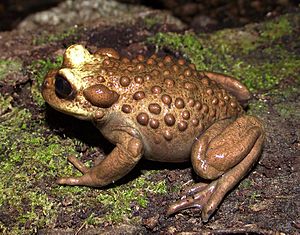Telmatobufo facts for kids
Quick facts for kids Telmatobufo |
|
|---|---|
 |
|
| A Telmatobufo bullocki frog | |
| Scientific classification |
|
| Kingdom: | Animalia |
| Phylum: | Chordata |
| Class: | Amphibia |
| Order: | Anura |
| Family: | Calyptocephalellidae |
| Genus: | Telmatobufo Schmidt, 1952 |
| Species | |
|
4, see text. |
|
Telmatobufo is a special group of frogs. They are sometimes called false toads because they look a bit like toads but are actually frogs. These frogs are found only in southern Chile. This means they are endemic to that area.
Their closest living relative is another unique frog called the helmeted water toad. This toad is the only species in its group, Calyptocephalella gayi. Scientists recently moved Telmatobufo frogs from one frog family (the Leptodactylidae) into a new family. This new family is called the Calyptocephalellidae. All three types of Telmatobufo frogs that have been checked by the IUCN are considered threatened. This means they are in danger of disappearing forever.
Contents
Meet the Telmatobufo Frogs
There are four known types, or species, of Telmatobufo frogs. Each one is unique!
Different Kinds of Telmatobufo
Here are the four species of Telmatobufo frogs:
- Telmatobufo australis (discovered by Formas in 1972)
- Telmatobufo bullocki (discovered by Schmidt in 1952)
- Telmatobufo ignotus (discovered by Cuevas in 2010)
- Telmatobufo venustus (first described by Philippi in 1899)
Why Telmatobufo Frogs Are Special
Telmatobufo frogs are important because they are found only in Chile. They live in cool, damp places, often near streams in forests. Like many amphibians, their skin needs to stay moist. They play a role in their local ecosystem.
Scientists are still learning about these frogs. It is important to study them to understand how to protect them.
Protecting These Frogs
Many Telmatobufo species are listed as threatened. This means their numbers are getting very low. They face dangers like losing their homes (habitats) due to human activities. Pollution and climate change can also harm them.
Organizations like the IUCN help track animals that are in danger. They give them a "threatened" status to show that they need help. Protecting these frogs means protecting their forest homes in Chile.
See also
 In Spanish: Telmatobufo para niños
In Spanish: Telmatobufo para niños

